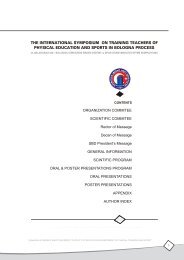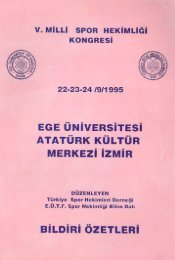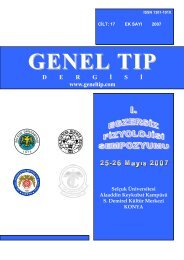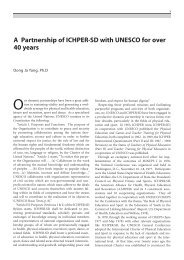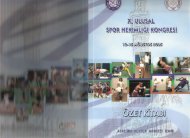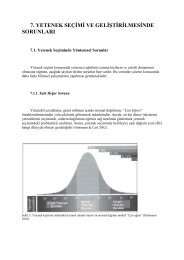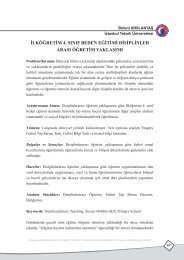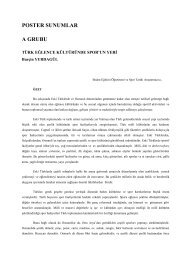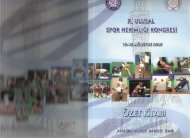KARDÄ°YORESPÄ°RATUVAR EGZERSÄ°Z TESTLERÄ° ... - Spor Bilim
KARDÄ°YORESPÄ°RATUVAR EGZERSÄ°Z TESTLERÄ° ... - Spor Bilim
KARDÄ°YORESPÄ°RATUVAR EGZERSÄ°Z TESTLERÄ° ... - Spor Bilim
Create successful ePaper yourself
Turn your PDF publications into a flip-book with our unique Google optimized e-Paper software.
7.ULUSLARARASI SPOR BİLİMLERİ KONGRESİ27-29 EKİM 2002KONGRE - PANELLERTALENT IDENTIFICATION AND DEVELOPMENT IN SOCCER: APRACTICAL PERSPECTIVEBarry DrustLiverpool John Moores University, Research Institute for <strong>Spor</strong>t and Exercise Sciences, LiverpoolIntroductionThe identification and development of talented youngsters are of interest to a wide variety of clubs andorganisations in sport. The early identification, selection and development of such individuals may provide acompetitive edge over opponents in competition (Morris, 2000) thereby ensuring the long term security of theorganisation in question.Interest in talent identification programmes and the development of young players has increased recently.This is especially true within the sport of soccer (Williams and Reilly, 2000). This expansion is probably theresult of the enforcement of European legislation regarding the movement of workers within the European Unionand a requirement to balance both the in and outflow of players and finance within clubs.Recognition of the benefits associated with the development of talent has led to a variety of differentschemes been developed and implemented by national governing bodies. The guidelines for the developmentof young players in England originated from the report produced by Wilkinson in 1997 entitled ―FootballEducation for Young Players – A Charter for Quality‖ for The Football Association of England‘s TechnicalDepartment. Recommendations for player development, based on extensive consultation with a variety ofstakeholders (such as Premier and Football League clubs, the Professional Footballers Association, the <strong>Spor</strong>tsCouncil of England, the Minister for <strong>Spor</strong>t and educational advisors), placed the player and his, or her interestsat the centre of the developmental process. This individual focus was supported by a principle of ―quality‖ in allaspects of provision.The proposed framework for the delivery of such recommendations was via the development of ―FootballAcademies‖. The remit of these academies includes the identification of players of outstanding ability and theirplacement in a educational programme that is designed to produce both football excellence and personaldevelopment (Wilkinson, 1997). These academies are attached to the major professional soccer clubs inEngland and are governed by the Football Association and the Premier League. Academy status is restricted toclubs that invest sufficient resources to reach a threshold of provision. This threshold includes set criteria forfacilities, coaching, medical provision, education and welfare and monitoring procedures.Talent Identification and Development : A case study of a Premier League Football ClubThe guidelines produced by the Football Association established a threshold for certain standards incertain areas for player development as previously mentioned. The guidelines for academies are, however,sufficiently flexible to allow individual clubs to adopt individual practices in the identification and development ofplayers. The following information represents an example of an identification and development strategy used bya current Premier League soccer club.Figure 1 illustrates the organisation structure of the Football Academy in question. The academy iscomposed of a number of different departments. These departments are responsible for talent identification(recruitment department) or a designated area of the development process (e.g. coaching, education andwelfare). Each department is overseen by the academy director who is ultimately responsible for the overallrunning of the academy.377



